Journey To Pascha
Come along with us on our liturgical journey to Pascha. (Easter) It consists of 40 days of Abstinence, (Parish Info: Fasting) the sacrament of Confession, weekly Divine Liturgies, evening Vespers, Presanctified Liturgies, and Akathist services. ( Holy Week and Sundays are not counted in the 40 days). Each week photos will be posted and a brief description of the event will be presented.
The word Pascha is the Hebrew word which means Passover. As Orthodox Christians we uses Pascha instead Easter. Pascha is used because it describes what Christ did for us. Just as the blood of the sacrificed lamb kept the angel of death away from the Hebrews (Ex. 12: 3-49) so it is Christ’s sacrifice as the New Passover Lamb (1 Cor. 5:7) and His blood allows us to “pass from death to life.” (John 5: 24)
The word Easter comes from the pagan goddess of Fertility. Easter is actually the Assyro-Babylonian demon Ishtar. She is also the goddess of adultery and a special patroness of accomplished liars. The rabbit associated with Ishtar under her German name Easter is a pagan fertility symbol connected with the worship of Ishtar. What makes the use of the word worse is that Ishtar-Easter is queen of heaven who is so strongly condemned by God as written by the Holy Prophet Jeremiah. (Jer. 44: 17, 29)
Pascha (Easter) is celebrated differently from the Catholic and Protestant churches because of the Jewish Passover. The Orthodox Church interpreted the proclamations of the First Ecumenical Council held in 325 AD that Pascha should never be before or coincide with the Jewish Passover because it is the new Passover. Therefore the date for Pascha varies from year to year based on the variablity of the Jewish Passover.
Forgiveness Sunday Vespers
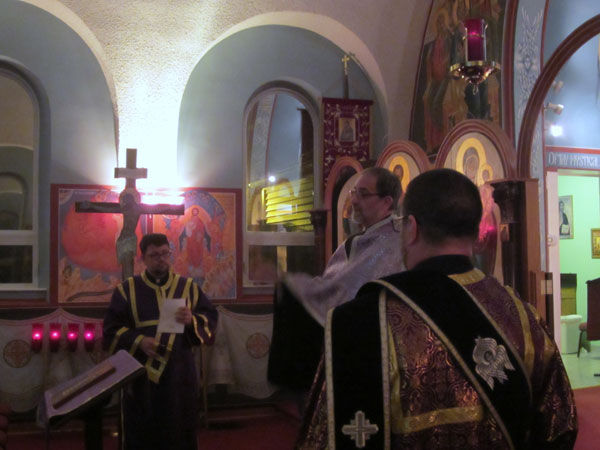
The first service of Great Lent is called Forgiveness Sunday Vespers. It is a standard Lenten weekday evening service. The verses sung refer to beginning Lenten fasting (Parish Info: Fasting) overcoming sin and of spiritual growth. The service ends with the prayer of St. Ephriam the Syrian that asks God to take away various passions and give various virues with a special emphasis on forgiveness.

At the dismissal Father Paul spoke about forgiveness. Then the parishioners one by one asked each other for forgiveness.
The Reading of the Canon of St. Andrew of Crete
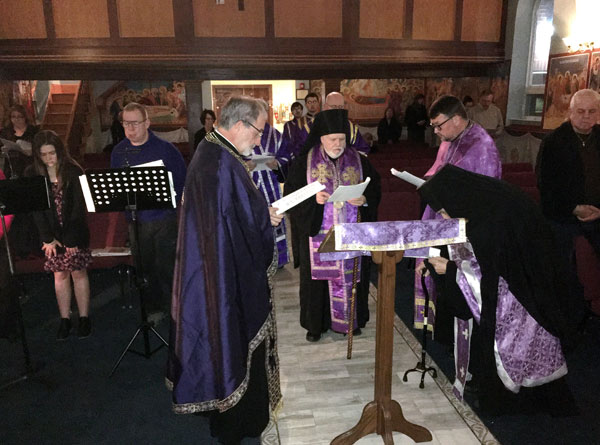
A canon is a liturgical poem divided into verses with a refrain. The Canon of St. Andrew, written in the 7th century, is divided into four sections, which are read on Monday through Thursday during Compline of the first week of Lent. St. Andrew, in composing the canon, traces the lives of people in the Bible who lived according to God’s commandments with those who failed. By doing this, St. Andrew reminds us of our failings and need of repentance. An example of a verse with refrain is the following:
Solomon was carried away by gratification of his lust. Alas, he who loved wisdom now makes love to prostitutes and finds himself estranged from God. But in your every thought you have imitated him, O my soul, through your disgraceful love of luxury.
Refrain: Have mercy on me O God, have mercy on me.
During the reading the faithful make prostrations (a bow with the head to the floor)
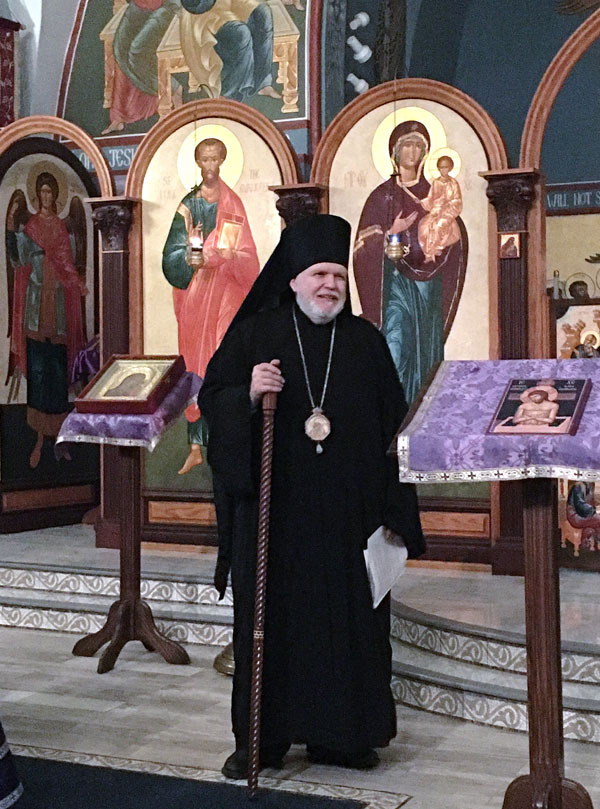
This year we were blessed to have His Grace, the Right Reverend Paul, Bishop of Chicago and the Diocese of the Midwest join us for the service. Following the service he spoke to us about the meaning of the Canon of St. Andrew.
Sunday of Orthodoxy
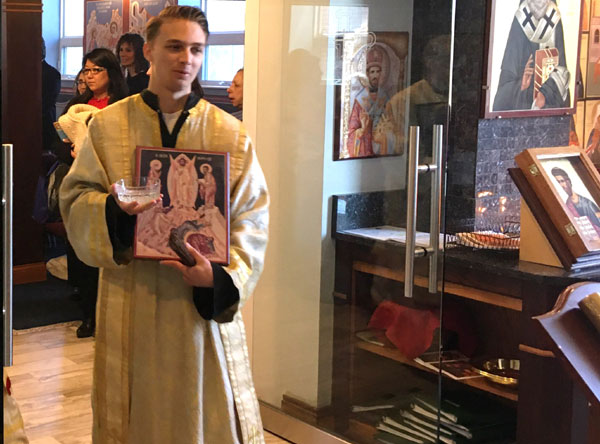
On the first Sunday of Lent, Orthodox Christians celebrate the official declaration of the 7th Ecumenical Council 787AD that the veneration of Icons is not the worship of images as the 2nd commandment describes. To celebrate the event, the parishioners of St. Luke held a procession of Icons, ( See Iconography) while the choir sang the hymn of the event. At its conclusion the proclamation of Orthodoxy and Creed were recited.
Proclamation of Orthodoxy:
As the Prophets beheld, as the Apostles have taught, as the Church has received, as the Teachers have dogmatized, as the Universe has agreed, as grace has shown forth, as Truth has revealed, as Falsehood has been dissolved, as Wisdom has presented, as Christ awarded; Thus we declare, thus we assert, thus we preach Christ Our True God, and honor His Saints in words, in writings, in thoughts, in sacrifices, in Churches, in Holy Icons; On the one hand worshipping and reverencing Christ as God and Lord, and on the other, honoring the Saints as true servants of the same Lord of All, and offering them proper veneration.
This is the Faith of the Apostles,
This is the Faith of the Fathers,
This is the Faith of the Orthodox,
This is the Faith which has established the Universe.
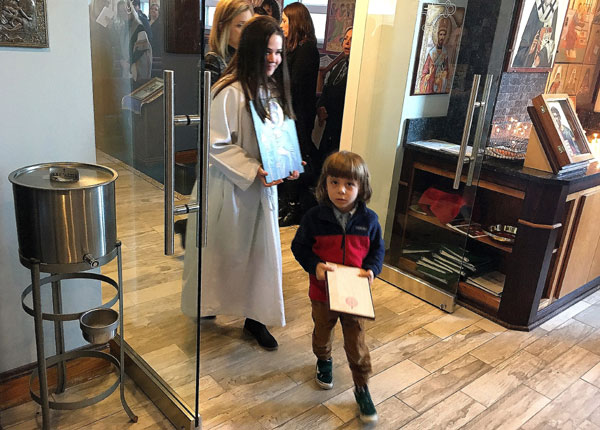
Scene from the procession.
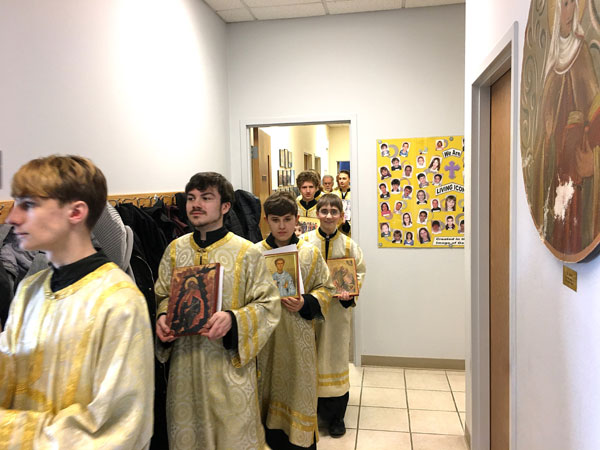
Scene from the procession.
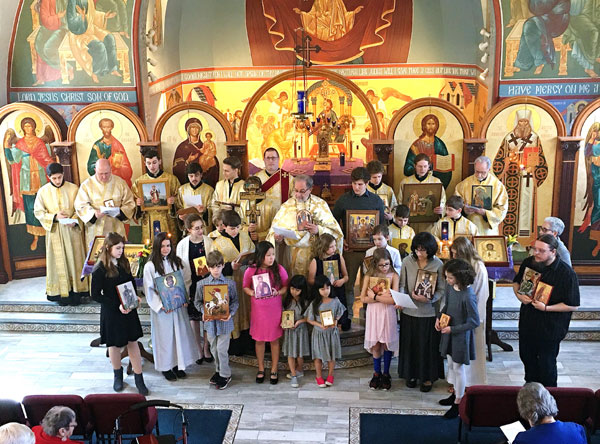
Scene from the procession.
Annunciation Liturgy
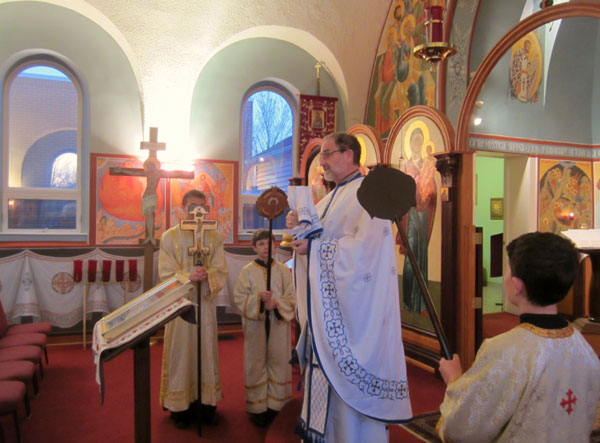
The Feast of the Annunciation breaks into the Lenten cycle because it is one of the 12 major feast days of the church and is part of the Nativity cycle. March 25th is nine months before Christmas. It commemorates the angel Gabriel visiting the virgin Mary and announcing to her that she was about to become pregnant by the Holy Spirit. Since it is a feast day the fasting rules are lifted slightly. For Greek Americans this is a special day because this is the day that Greece became independent from the Ottoman Turkish empire in 1821 – 1827.
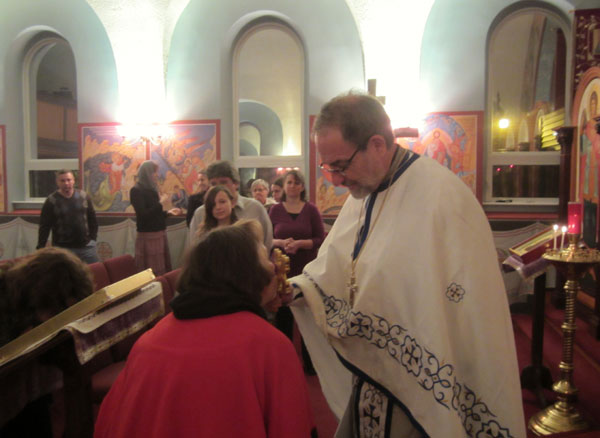
The Annunciation falls during Lent, but it is always celebrated with great joy. The Liturgy of St. Basil or St. John Chrysostom is served, even on the weekdays of Lent. It is one of the two days of Great Lent on which the fast is relaxed and fish is permitted (Palm Sunday is the other).
Presantified Liturgy
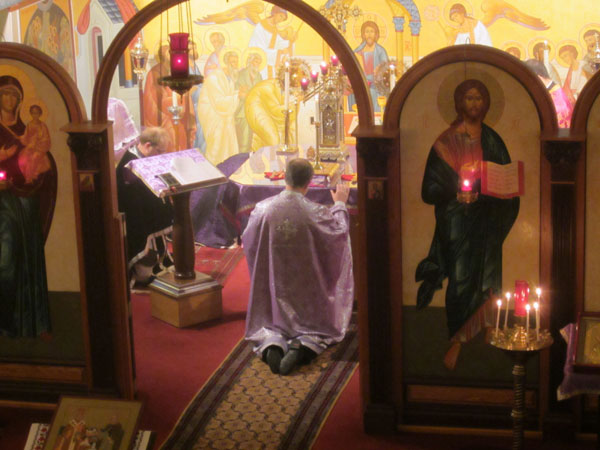
On Wednesdays during Lent the Presanctified Liturgy is celebrated. The word Presanctified refers to Holy Communion which has been consecrated on the Sunday before and distributed at the Presanctified Liturgy. One of the special features of this liturgy is the solemn blessing with a single lighted candle by the Priest who announces “The Light of Christ illumines all!” The faithful make a prostration. The scriptural readings are from Genesis, Exodus, Isaiah and Proverbs signifying the preparatory nature of this service.

Following the service all are invited to join in a pot luck lenten meal.
Akathist Service
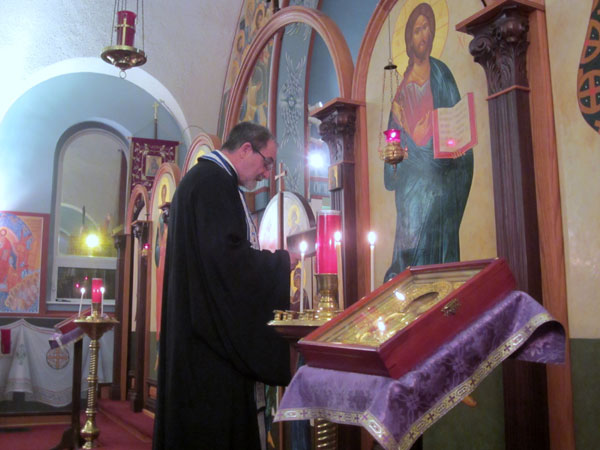
In some Orthodox Churches of the Russian Tradition the Presanctified Liturgy is celebrated both on Wednesday and Friday. Churches of the Greek Tradition celebrate the Akathist (salutations) to the Virgin Mary on Friday. An Akathist Hymn is a liturgical prayer of praise written about Christ, a certain saint or a need such as thanksgiving. The Akathist Hymn to the Virgin Mary portrays her as a compassionate mother who cares for us through her prayers. During Lent this is necessary because of the spiritual battle which we have undertaken.
Sunday Of The Cross
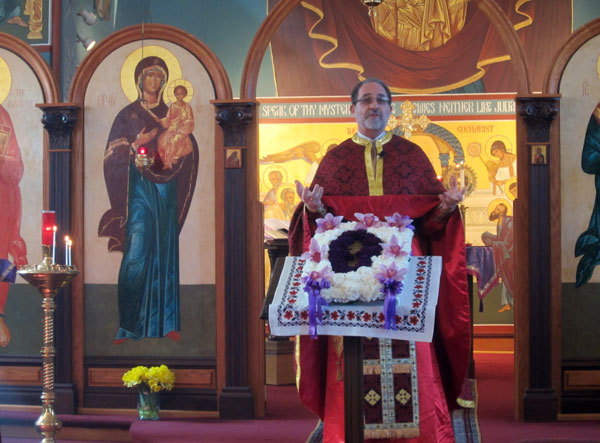
The third Sunday of Lent is the half way point of Great Lent. On this Sunday a flower decorated cross is displayed in the center of the sanctuary during the Liturgy.
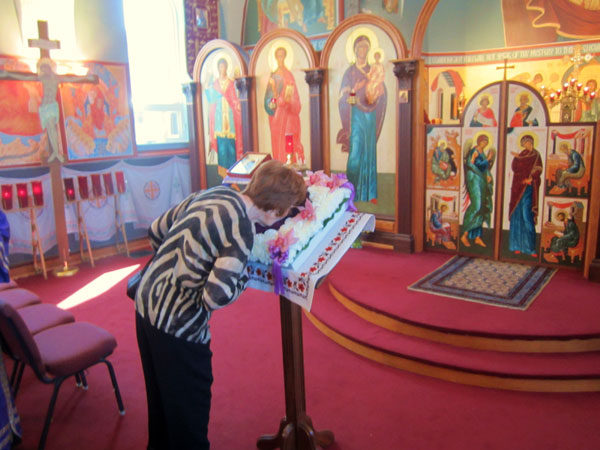
At the point in the Liturgy when normally “Holy God” is sung it is replaced with “Before Your Cross we bow down and worship You.” During this hymn three prostrations are made. They signify our devotion to God and that we have accepted His cross. It is also given as a help to fight off the attacks of the Devil who during Lent wants us to fail in our fast and it helps us to keep our heart pointed toward the Cross and Christ’s victory over death at Pascha.
At the end of Liturgy, parishioners venerate the cross.
Soul Saturday

Saturday, the Sabbath day is considered the day devoted to the departed in the Orthodox Church. It is the day God rested and the day Christ rested in the tomb while his soul descended into Hades. On the Saturdays of Great Lent a liturgy is celebrated to commemorate departed parish and family members. Each person is commemorated by name. A special cake of boiled wheat, honey and raisins is prepared and is blessed during the memorial service. This cake is symbolic of the dead planted as a grain of wheat waiting for the resurrection to life eternal in heaven, the land of milk and honey. The raisins symbolize the fruits of the Holy spirit.
Lazarus Saturday
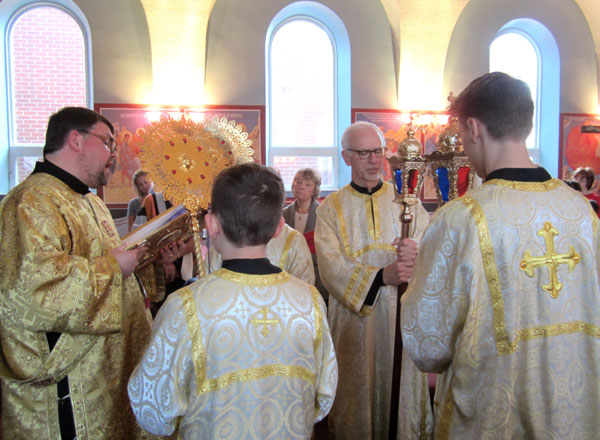
On Lazarus Saturday Liturgy is held. Here the gospel concerning the resurrection of Lazarus is read. It is on this day that we hold First Confession for those children who are of age.
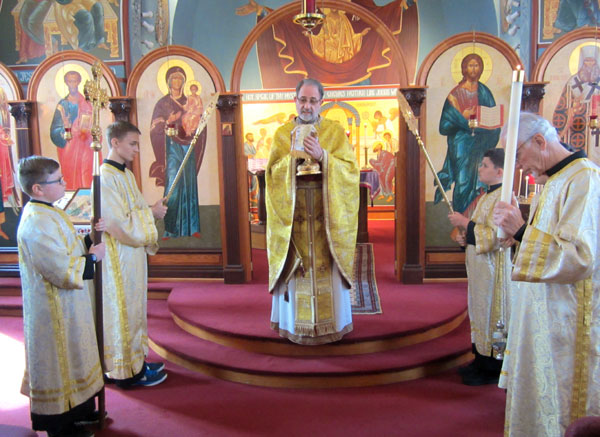
Great lent officially ends on Lazarus Saturday. The Liturgy of St. John Chrysostom is celebrated to commemorate the raising of Lazarus. Notice that Fr. Paul is wearing gold vestments. This change in color denotes the resurrectional nature of this service as a prelude to Holy Week. Because of it resurrectional character the hymn as many as have been baptized into Christ is sung. Historically this was a baptismal liturgy.
Palm Sunday

The hymn of Palm Sunday proclaims the children holding the emblems of victory singing, “Hosanna blessed is he who comes in the name of the Lord.” We experience Christ’s triumphal entrance into Jerusalem by processing around the church holding palm and pussy willow branches as symbols of Christ’s ability to overcome death by raising Lazarus.

The Gospel Reading.

The Great Entrance

Michelle leads the children singing a communion song. “Out of the mouths of babes and infants, God has fashioned perfect praise.”

Father Paul blesses the palms.
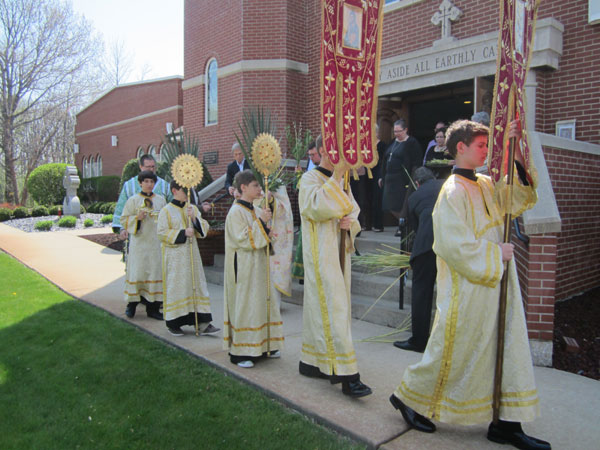
At the end of Liturgy, the parishioners all received palms and branches and went outside for a procession led by the clergy around the church singing the Troparion of the day.

Scene from procession.

Greeters hand out palms and branches.
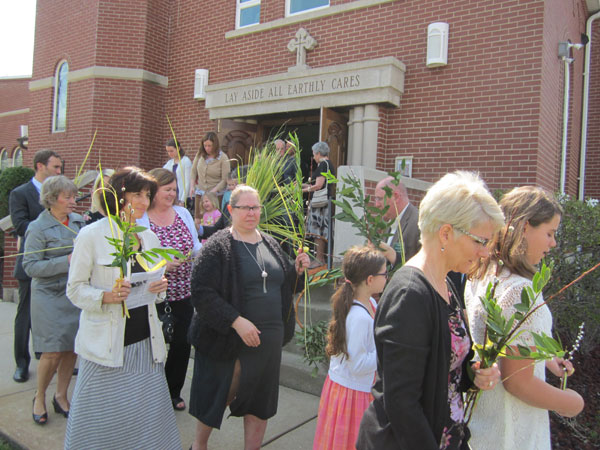
Scene from procession.

Scene from procession.

Scene from procession.
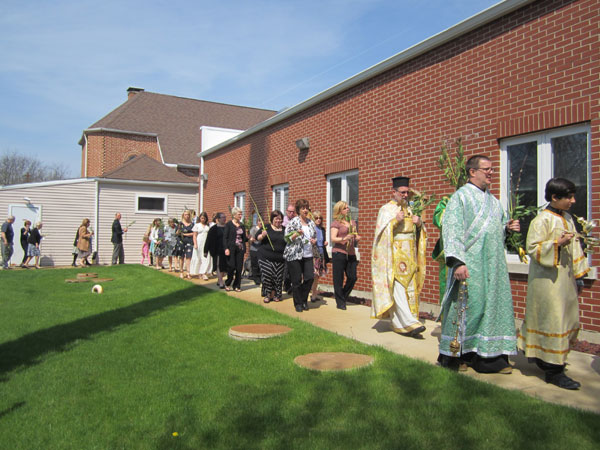
Scene from procession.

Scene from procession.

Scene from procession.
Holy Week
Monday – Bridgegroom Service
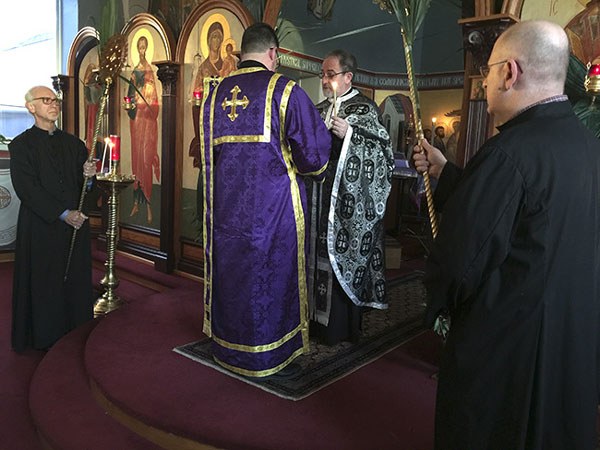
On Holy Monday there is a Bridegroom Service – Bridegroom Services instruct us in our faith, as does all the preparation for Holy Week. Even more they help us to make Holy Week more than simply a ritual that tells a story. The Bridegroom Services help us to enter into the story, the life of Jesus Christ, and live it.

On Monday night, the priest represents Christ and the congregation represents the bride waiting for the bridegroom. As the virgins were called to be vigilant and prepared for the coming of the bridegroom lest they be shut out of the bridal chamber; let us be likewise vigilant and prepared, lest we be shut out of the eternal kingdom. – Matthew 25: 1-13
Monday’s Gospel Lesson
Monday’s Gospel lesson is Matthew 22: 15-46 and 23: 1-30. “Woe unto you Scribes and Pharisees, Hypocrites”
Tuesday Bridegroom Service

Tuesday’s Bridegroom Service with the procession of the hymn of St. Cassian describes the life and conversion of the sinful woman who anointed Christ. The congregation is blessed with rose water. The rose water is symbolic of the sweet smelling myrrh with which the sinful woman anointed Christ. The scriptures tell us that the whole room was filled with the scent of myrrh. Once again it is important to understand that this is simply not a play being reenacted, but rather we are attempting to enter the life of Christ.
The symbolic acts in the services draw us unto the life of Christ. Through these acts we venerate the individuals that these acts depict.
Tuesday’s Gospel Lesson
John 12:17-50 “The hour has come for the son to be glorified.”
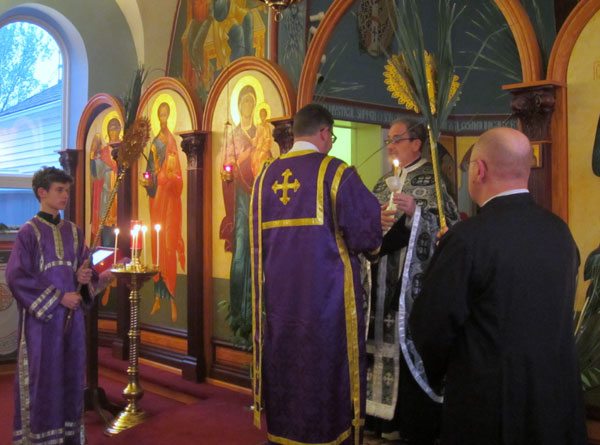
Wednesday Holy Unction Service

Sacrament of Holy Unction – The Church is called the Body of Christ. We are members of the Body through our Baptism, Chrismation, Confession, and Holy Communion. As the sinful woman anointed Christ, we are also anointed with the oil of healing, so we can go with Christ to the Cross, suffer, die, and be resurrected with Him.

The Gospel Reading.
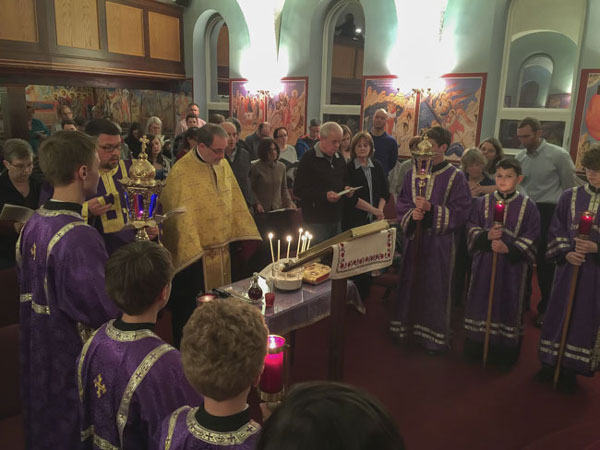
Father Paul prays over the Holy Oil.

During the service all who are in need of special healing gather together in the center of the church. The priest holds the open Gospel over them and reads the Prayer of Absolution. Epistle and Gospel lessons regarding healing are read. “The prayer of the faithful will save the sick.” (James 5:15) We prepare for this service by prayer and fasting from noon.

At the conclusion of the service, the faithful are anointed with the sacrament of Holy Unction. The priest anointes each of the faithful with the oil of healing on various parts of the body: forehead, eyes, ears, mouth, chest, palm, and the back of each hand. These areas are associated with the senses of smell, hearing, taste, and touch. The neck or chest is anointed for breath and for the heart.
Thursday Morning – Mystical Supper Liturgy
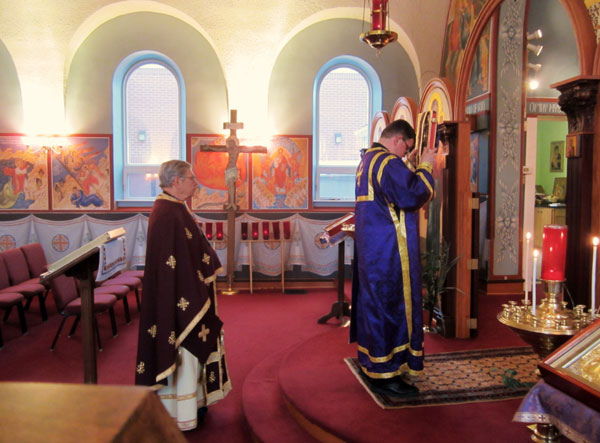
Vesperal Liturgy of St. Basil – This service relives the Lord’s Supper and betrayal by Judas. The hymn “Of Your Mystical Supper, O Son of God” is sung throughout the service. At the conclusion of the service, breakfast is served as an agape meal.

Thursday Evening – The Passion Gospels

Passion Gospel Service – This is one of the most important and solemn Holy Week services. It is a remembrance and an entrance into the suffering and death of Christ.
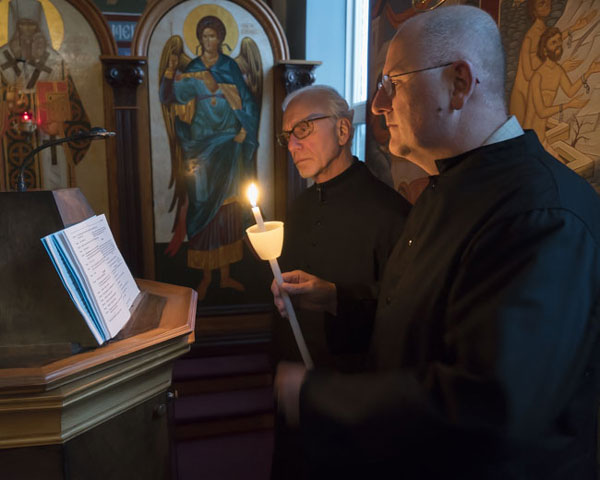
Readers chant the responses.
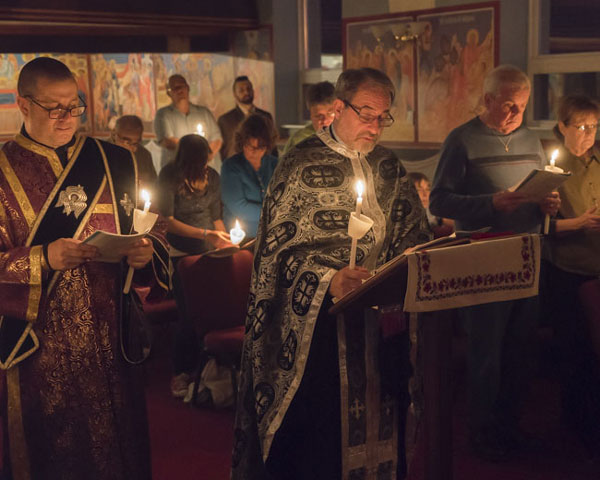
The priest, standing in the center of the church reads the words of the apostles who witnessed the events.

During the fifth reading, the priest processes with the Cross carried his shoulder as he chants, “He who hung the earth upon the waters is now being hung on the cross.” As Simon carried the cross for Christ during his walk to the crucifixion, the priest now carries the cross. In doing so here presents the entire congregation.

At the point of the sixth Gospel when “He yielded up the spirit” is read, the priest places a wreath of red flowers over the cross.” (This is the moment in the scripture reading when Christ died).

Following the placing of the wreath, the hymn “The Wise Thief” is sung in remembrance of the thief who was crucified with Christ and accepted Him while on the cross.

At the conclusion of the service parishioners venerate the cross.
Royal Hours

On Friday morning Royal Hours is celebrated. Historically it was named after the Emperor who would attend the service at this time. Today we still have the service because it traces the events that happened to Christ each hour on Holy Friday.
Friday Morning – Preparing The Tomb

Following the crucifiction, the myrrh bearing women prepared the tomb and Christ for burial. The women of the parish decorate the tomb of Christ with flowers.
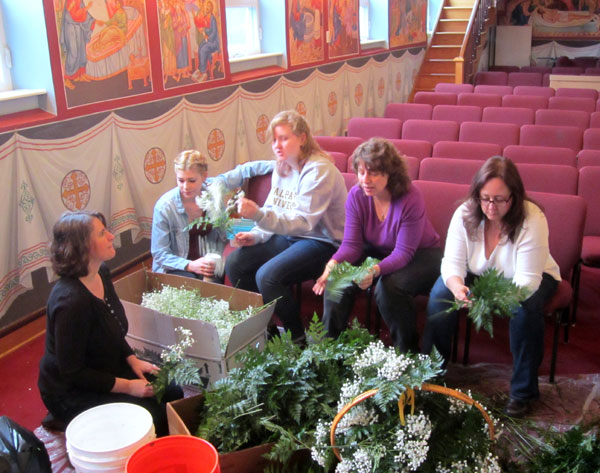
The women prepare the tomb.
Friday Afternoon Procession With The Burial Shroud
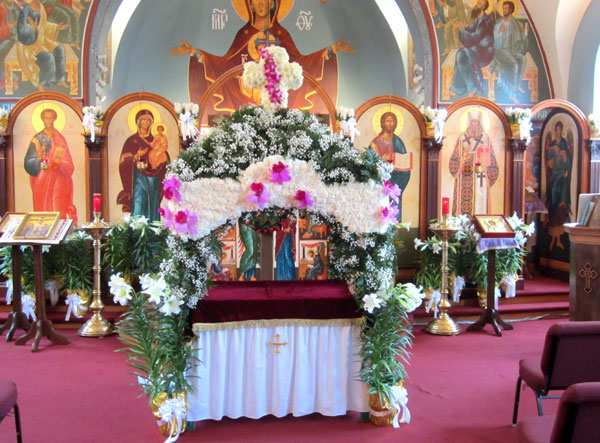
Procession with the Burial Shroud – At this service the icon of Christ is removed from the Cross as the priest reads,”And taking Him down they wrapped Him in a linen shroud.” The tomb prepared by the women stands empty in the center of the church. The shroud is carried by four men over the head of the priest who is carrying the gospel as the choir sings the “Hymn of Noble Joseph”. The procession ends as the shroud is placed in the flower-decorated tomb. While the lamentations of the Virgin Mary are sung, the faithful make a prostration before the tomb and kiss the wounds on the figure of Christ on the shroud.
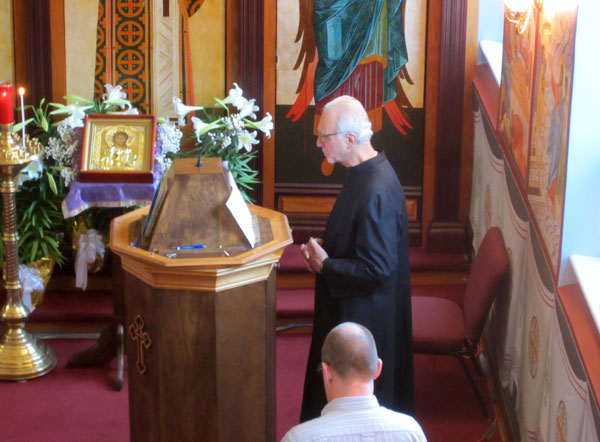
The reader chants for the service.
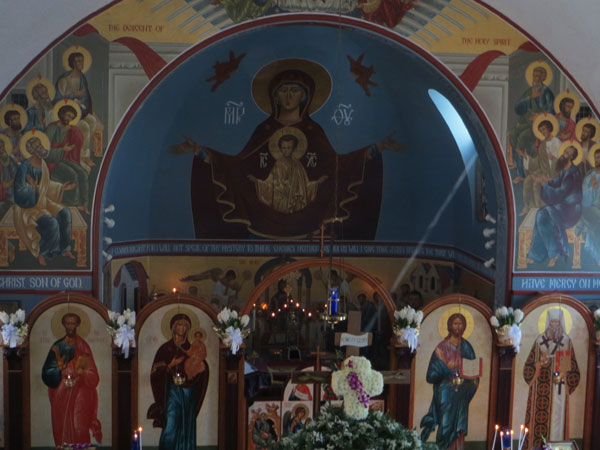
A beam of light shown thru the window near where the burial shroud lay on the altar.
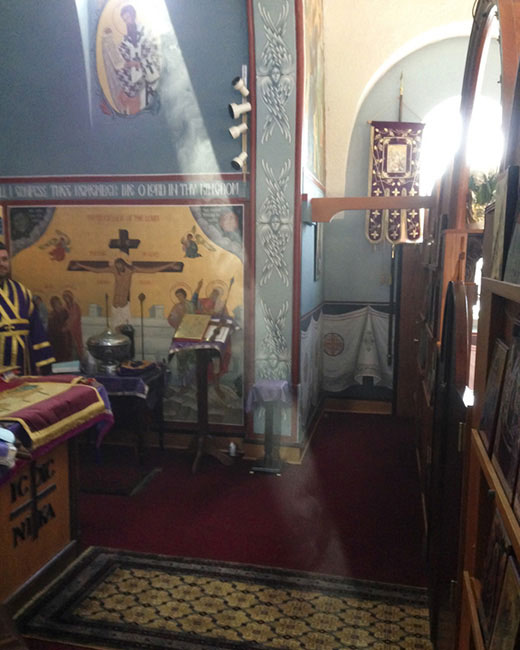
The beam of light in front of the altar.
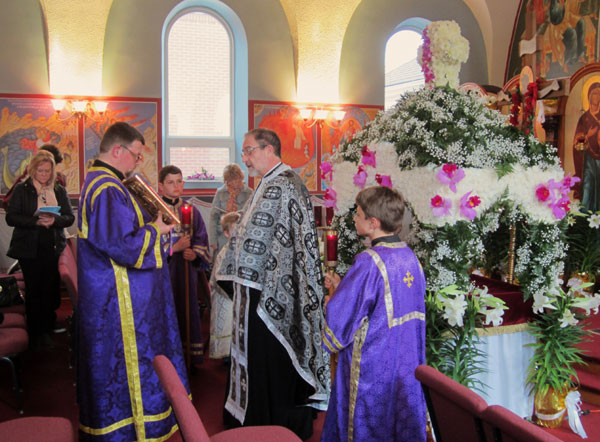
Here Father Paul reads the Gospel.
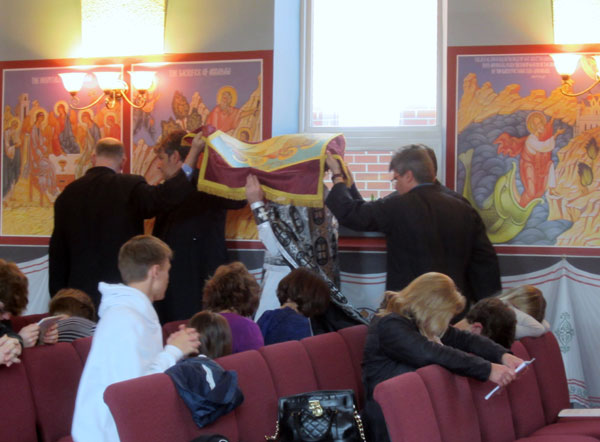
Procession with the burial shroud.

Procession with the burial shroud.
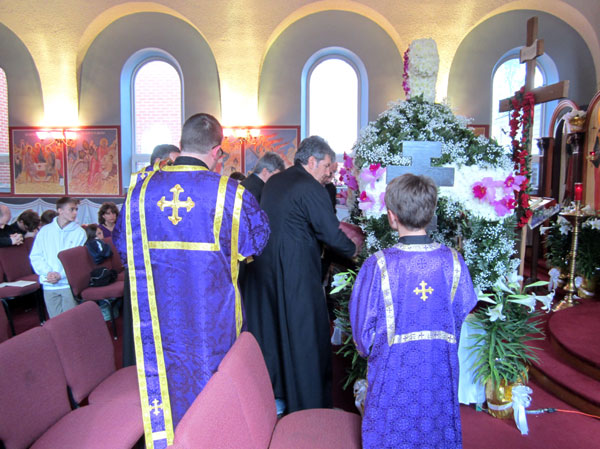
Burial Shroud is placed in the tomb.

Scene from the service.
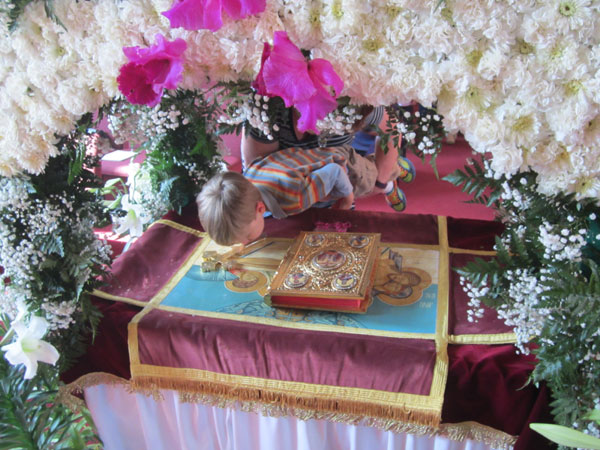
Parishioner venerates the Burial Shroud.
Friday Evening The Lamentations

As the name suggests the service is a mournful one lamenting the death of Christ. Psalm 119 “Blessed are those who walk in the law of the Lord.” is chanted by the priest. The refrains are sung by the congregation, “O Life, how can You die?”. During the singing of the 9th ode of the Canon, the priest blesses the congregation with rose water as rose petals are scattered around the church.
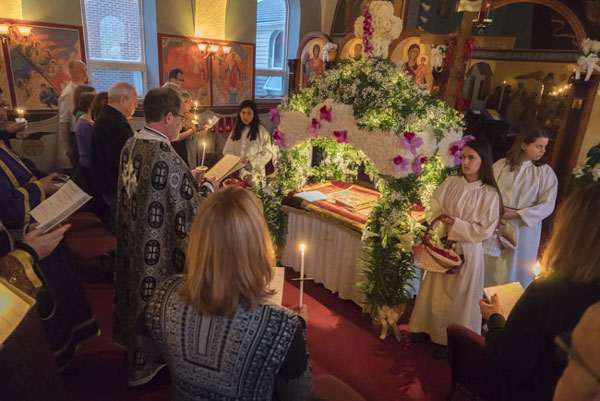
Here we see some of our handmaidens standing guard at the tomb.

Scene from the service.
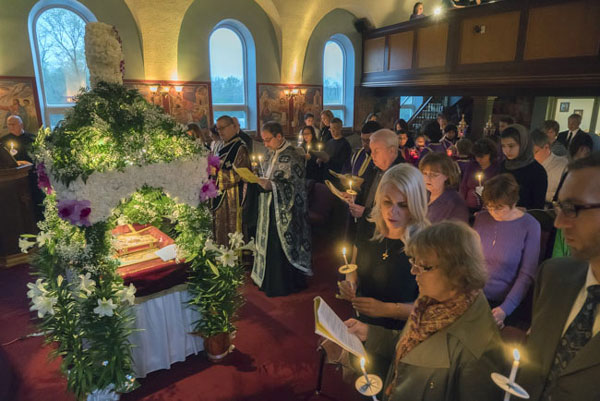
Scene from the service.
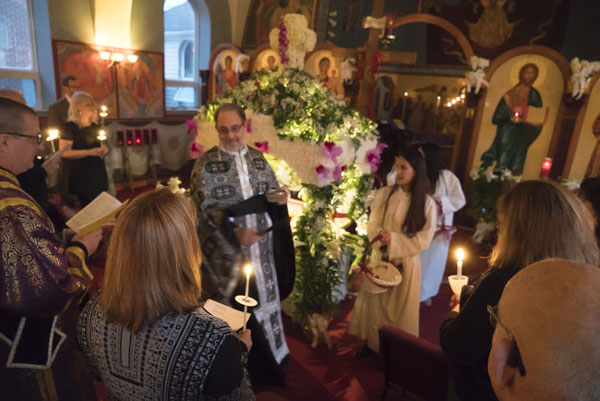
Father Paul blesses the congregation with Rose Water.
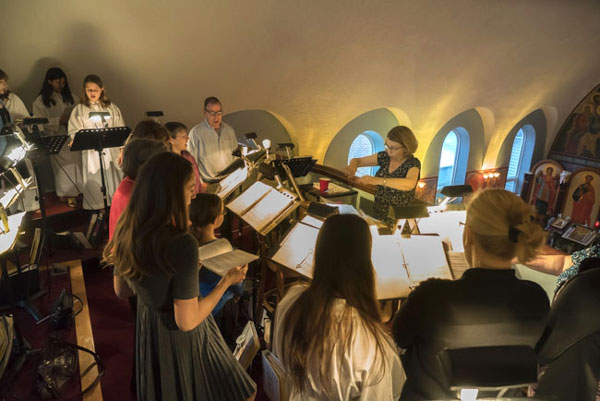
The choir.

The youth sing hymns directed by Choir Director Michelle.
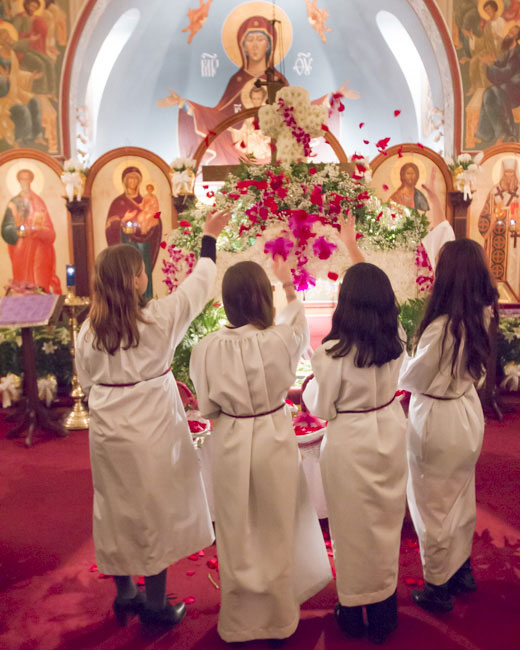
Rose petals are scattered around the church by the handmaidens.
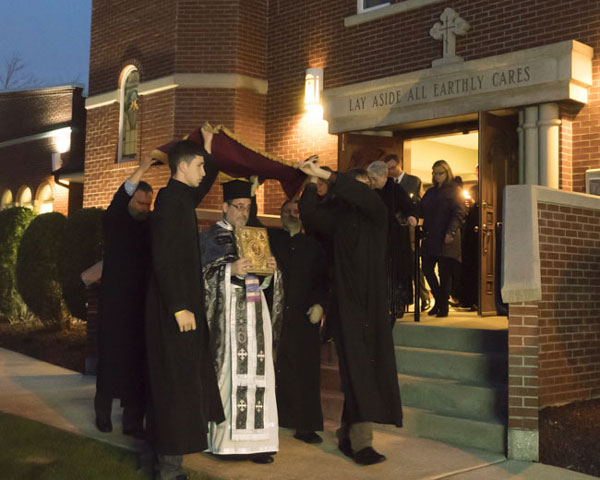
During the service, the shroud is removed from the tomb and four men along with the priest, choir and entire congregation make a procession around the entire exterior of the church while the “Hymn of Noble Joseph” is sung. They return to the church to hear the reading Ezekiel about the valley of the dry bones. The service ends with the veneration of the shroud and the distribution of flowers. Immediately following this service the vigil of the tomb begins and continues all the way up to Saturday morning.
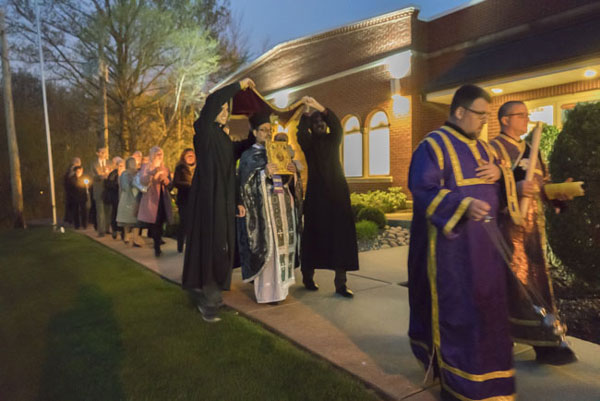
Scene from procession.

At the end of the procession, parishioners venerate the Gospel.

The procession is concluded as the parishioners reenter the church walking under the burial shroud.

The Burial Shroud is placed back into the tomb.
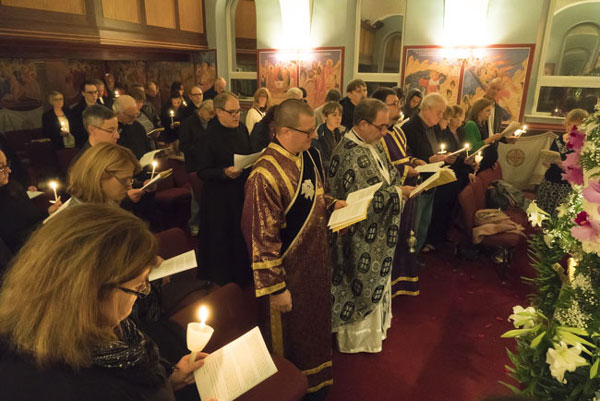
The reading of The Prophecy of Ezekiel.

The Gospel Reading.
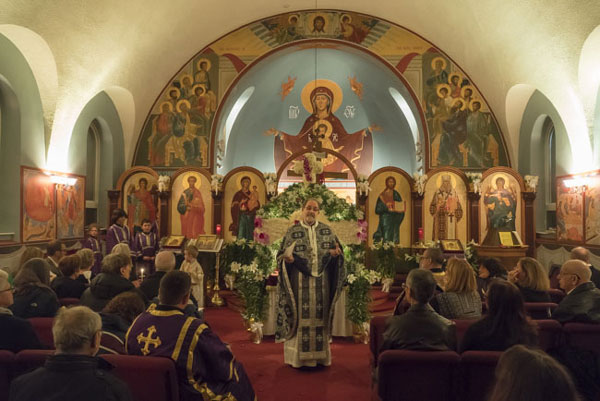
Father Paul teaches about the service and then parishioners venerate Christ in the tomb.
Vigil
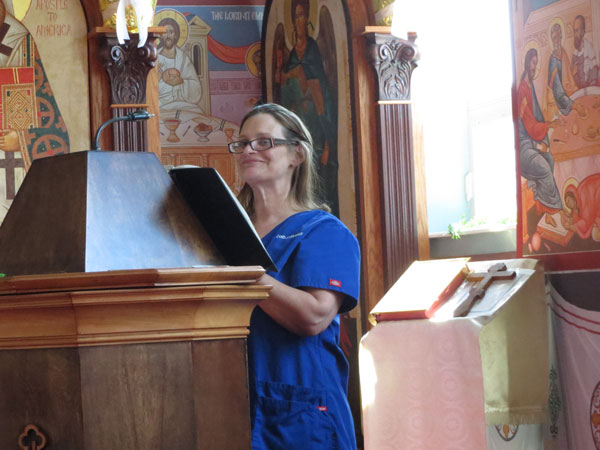
Following the Lamentations on Friday night, parishioners volunteer to stand watch and “guard” the tomb of our Lord. This vigil lasts for 24 hours until the Pashcal services the following night. The church remains open during this time for visitors to come and worship before the tomb. The mood is that of a present-day wake. Bible verses are read during this time.
Saturday Morning
Holy Week – Holy Saturday Liturgy
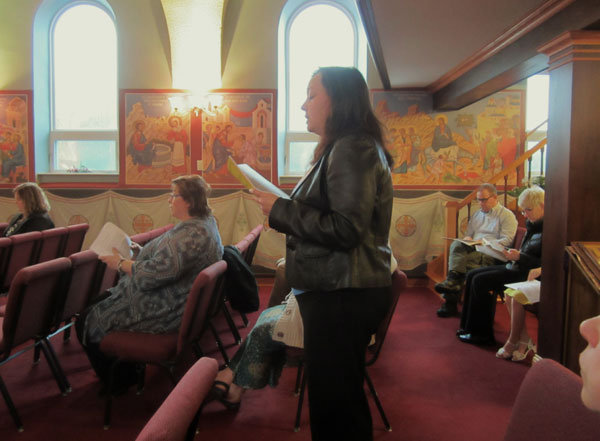
Holy Saturday Liturgy celebrates Christ’s descent into hell to free Adam and Eve and all who lived and died in anticipation of the coming of Christ. Historically this service was a time for new members to be chrismated into the church.
During this Vesper service, 15 different readings from the bible are read. The readings all refer to resurrection.
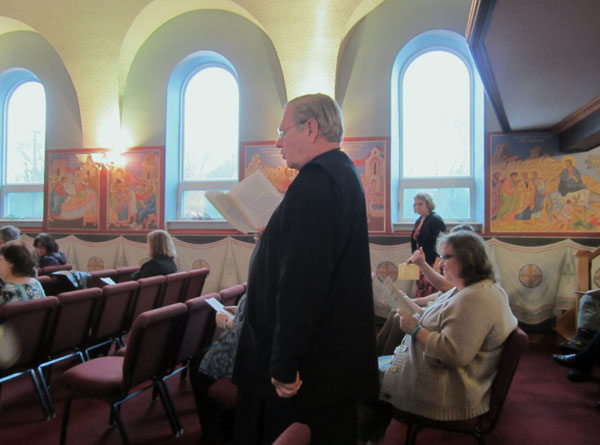
Here Father Andrew reads the 15th reading concerning the Three Holy Youths and the Fiery Furnace.
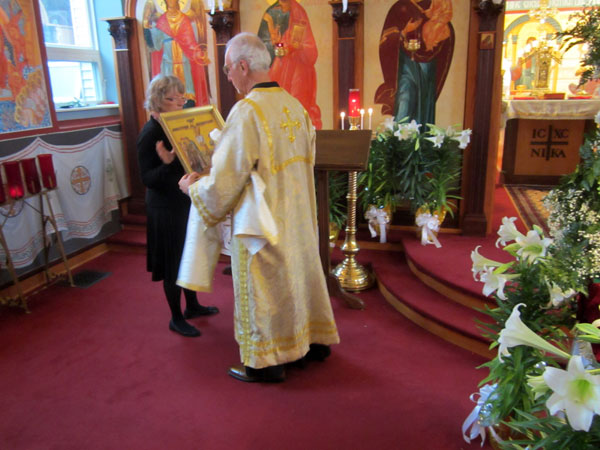
The clergy and servers begin the service all dressed in their lenten colors. At the point when Christ raises out of hell, the covers are changed. The priest, deacon, and altar servers change their vestments from the somber dark colors of lent to white. The words “Let God arise,” are said. The altar cloths and candle holders are also changed at this time.
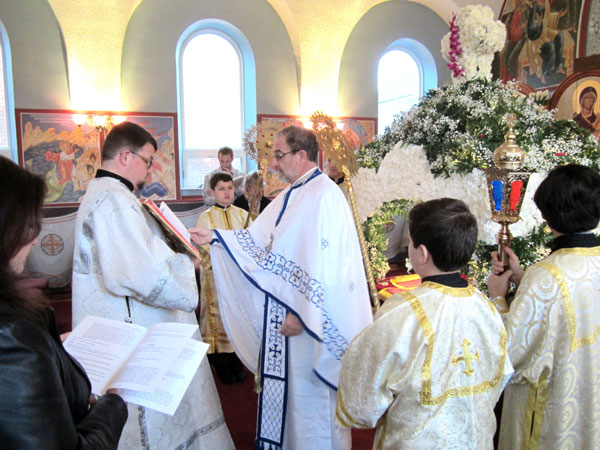
The Gospel reading.

Scene from the Liturgy.

Following the Liturgy, parishioners venerate the icon of Christ and the Eucharist is extended into an agape meal consisting of wine, bread, fruit, dates, figs, and nuts.

Pascha – Saturday Night/Sunday Morning
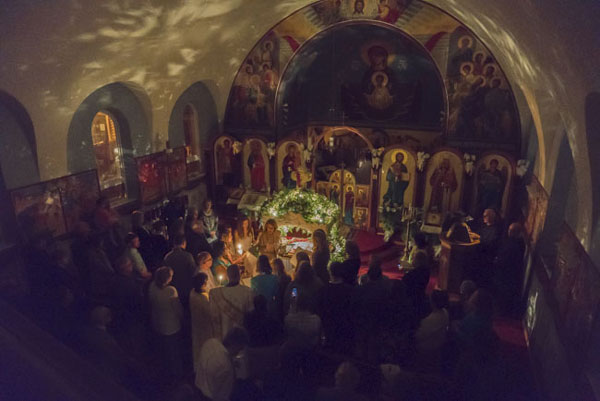
All the preparations have been for this night. The church is ready and the faithful have spent the day in strict fast. There is a sense of anticipation in the air. The church is darkened and the music selections are somber as during all of lent.
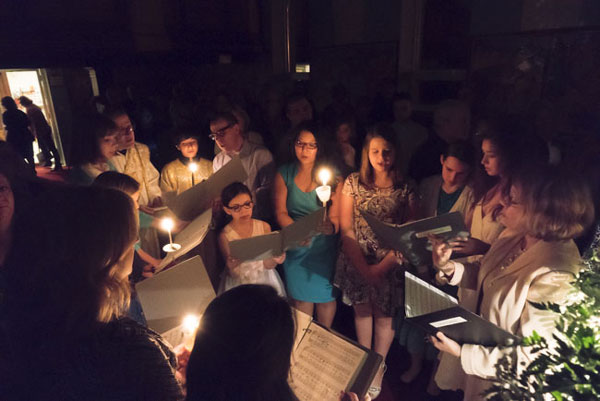
The nocturns are sung at the tomb of Christ.
To hear a small sample of The Nocturnes please click here.
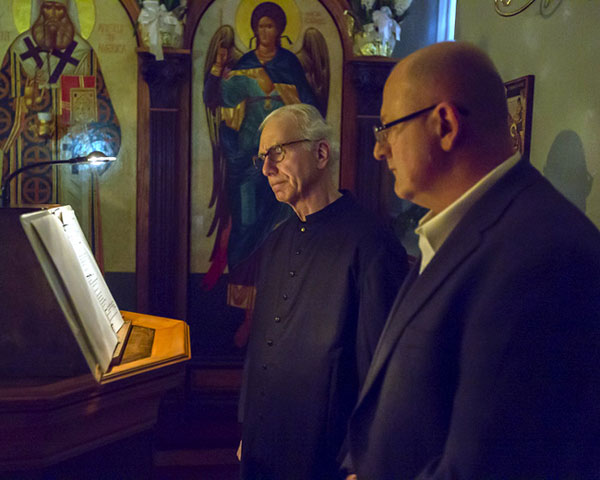
The readers chant the responses.
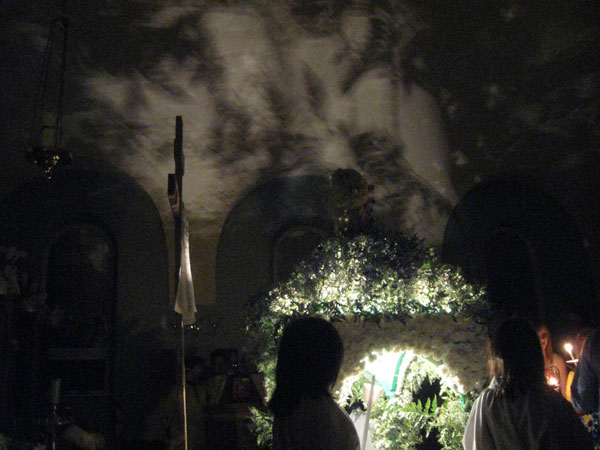
The handmaidens guard the tomb. The light from the tomb throws shadows on the ceiling of the church.

All lights in the church are extinquished and there is a total darkness. At midnight the flame from a single candle appears at the altar. The priest brings forth the light of Christ and gives it to the rest of the faithful.
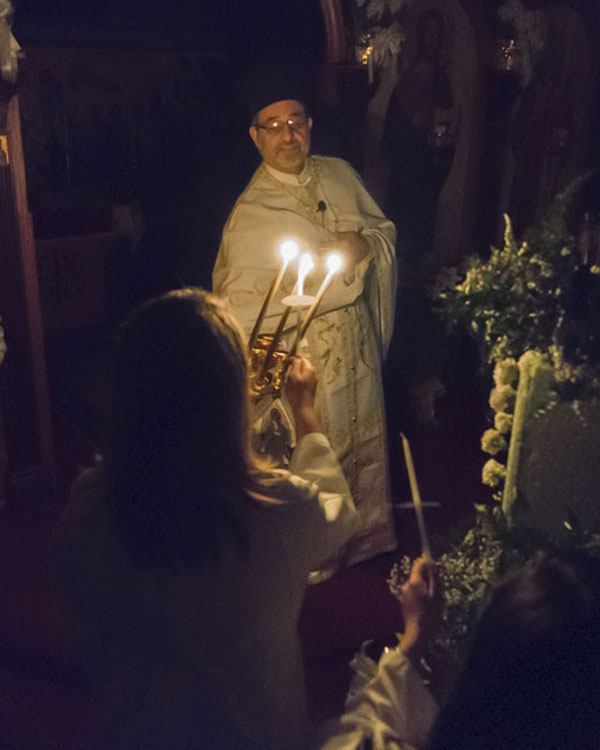
Father Paul spreads the Light to the handmaidens and from there it spreads to all the congregation.

The Handmaiden gives the light to a parishoner.
.
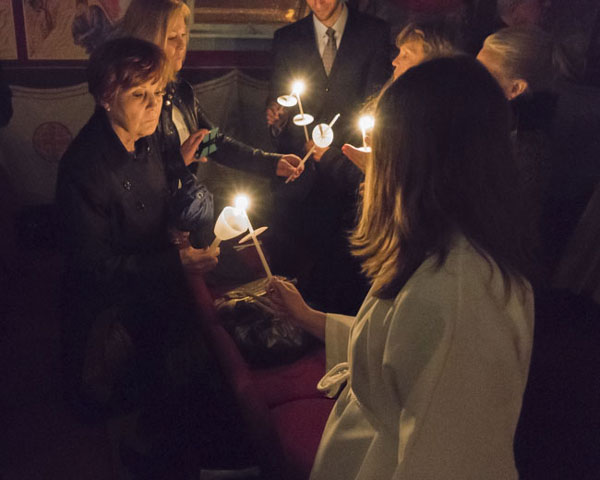
Parishioners spread the Light.
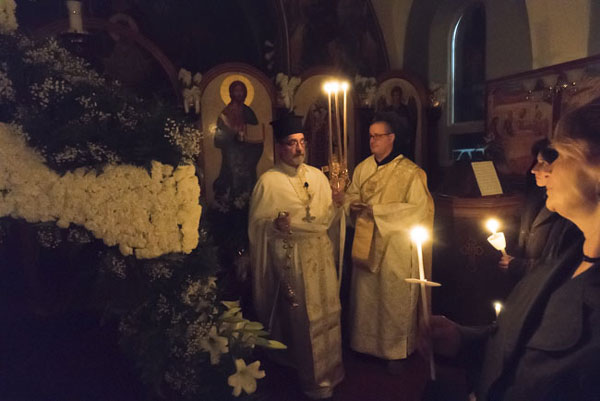
“Come Receive Ihe Light”.
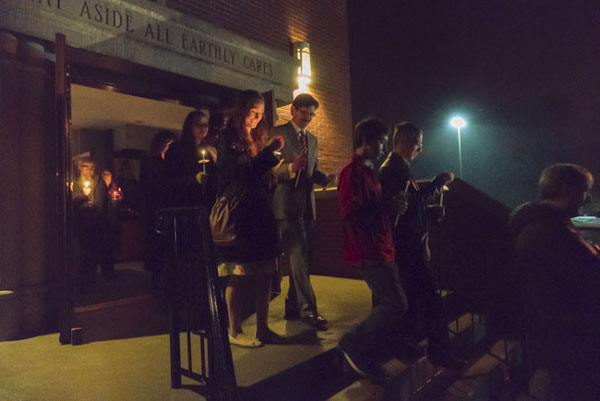
The entire congregation leaves the church in procession and proceeds around the church.
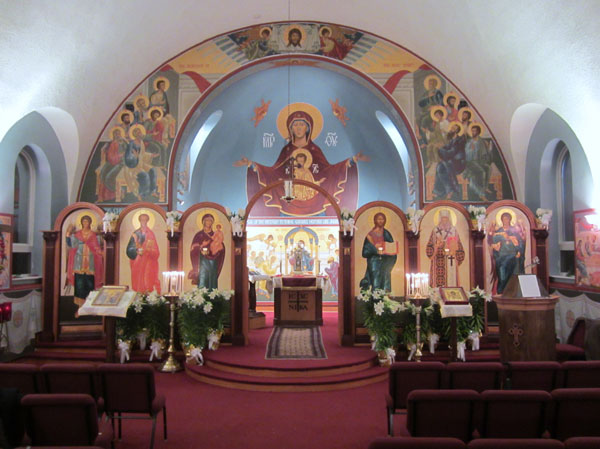
While they are doing this, the tomb is removed from the church, all the lights are turned on, and all candles are lit once again symbolizing Christ’s resurrection.
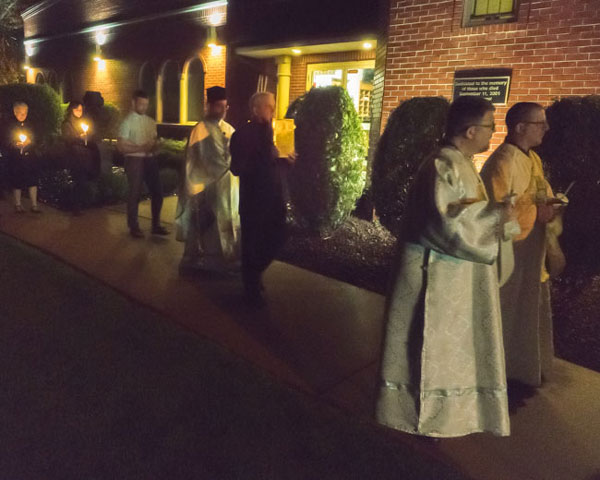
Scene from the procession.
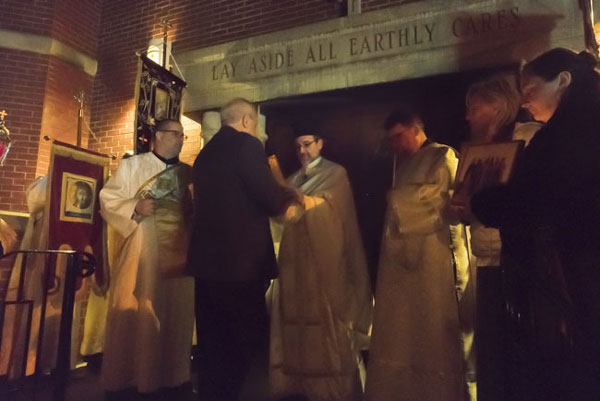
Upon finishing the procession around the church, the congregation gathers at the closed front doors of the church.
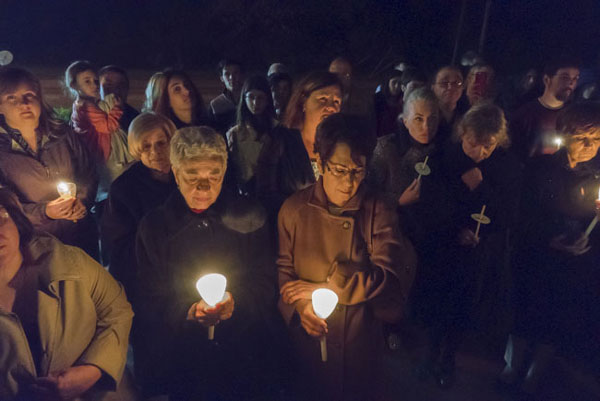
Scene from the procession.
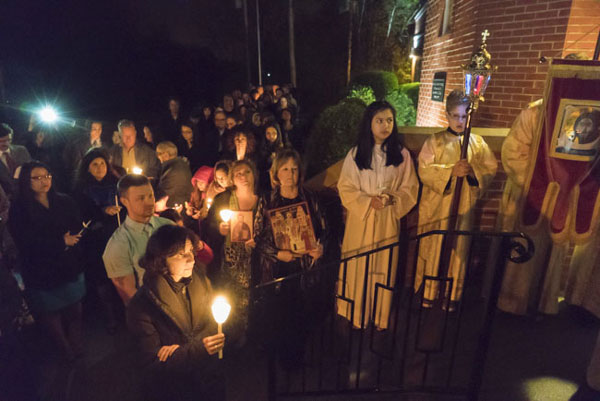
Scene from the procession.
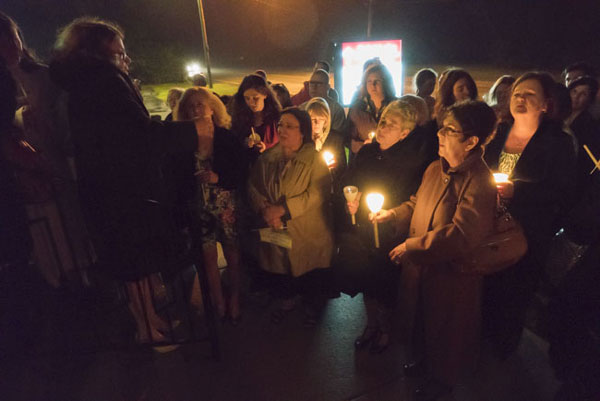
Scene from the procession.
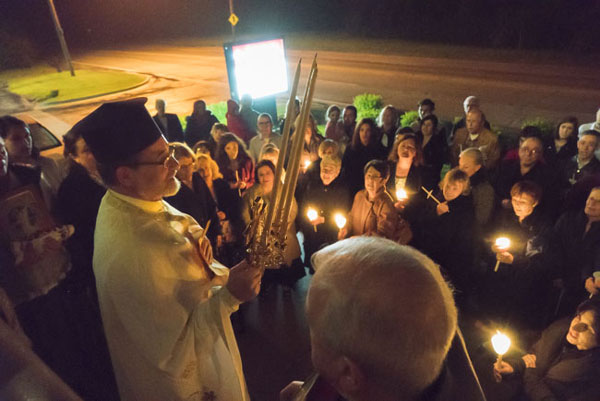
Scene from the procession.
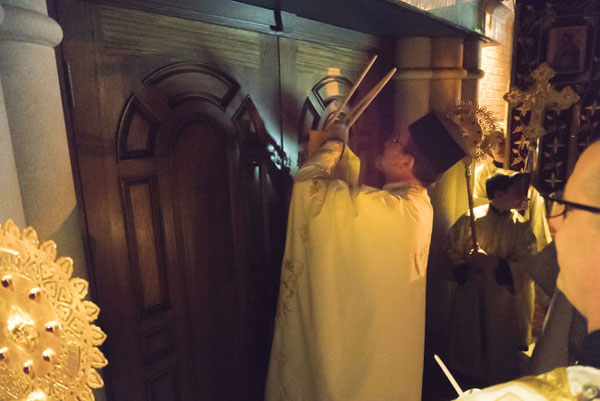
The Priest knocks on the doors three times saying: Lift up your heads, O ye gates; and be ye lift up, ye everlasting doors; and the King of glory shall come in. And a voice asks: Who is this King of Glory? The priest answers: The Lord strong and mighty, the Lord mighty in battle. The priest the knocks again saying: Lift up your heads, O ye gates; even lift them up, ye everlasting doors; and the King of glory shall come in. And again the voice asks: Who is this King of Glory? The priest then replies: The Lord of hosts, he is the King of Glory.
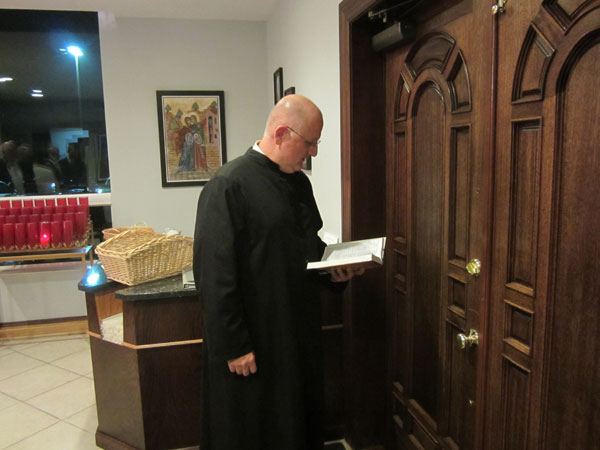
“Who is this King of Glory?”
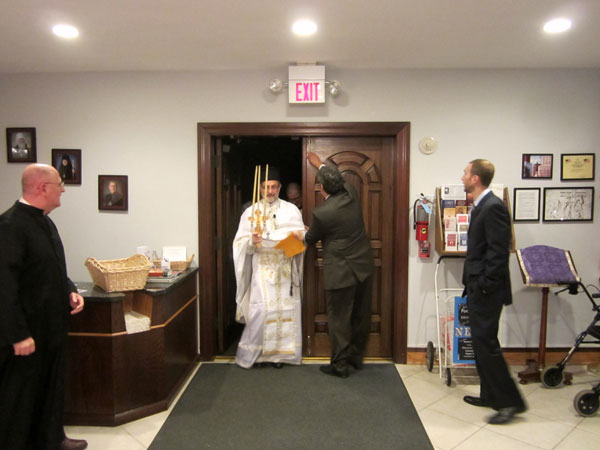
The doors of the church are opened, the tomb has been removed, the entire building is filled with light and it is now time to begin the joyous Resurrection Service. The priest reenters followed by the congregation.
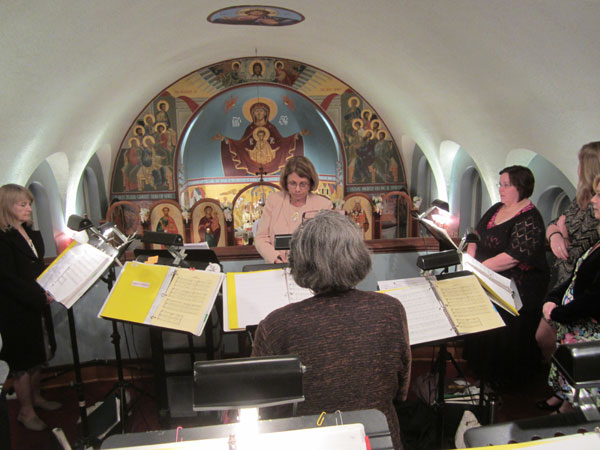
Led by our choir director, Michelle the chanters sing the songs of the resurrection.
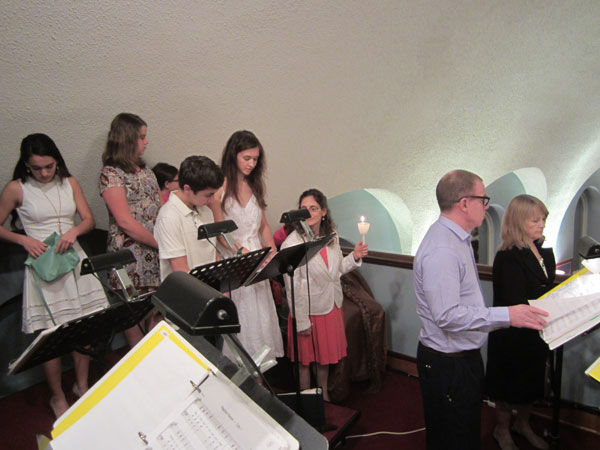
Another view of our chanters.
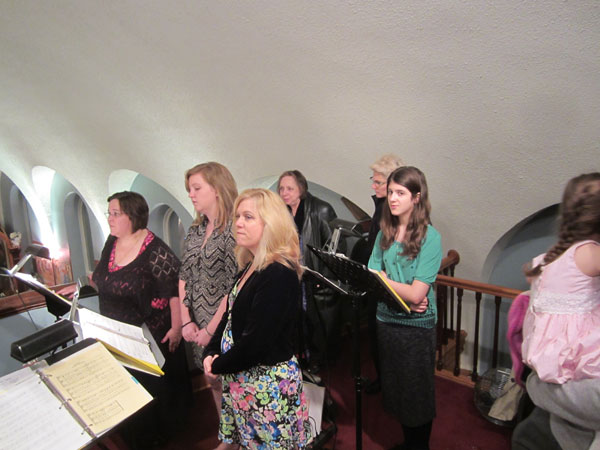
Another view of our chanters.
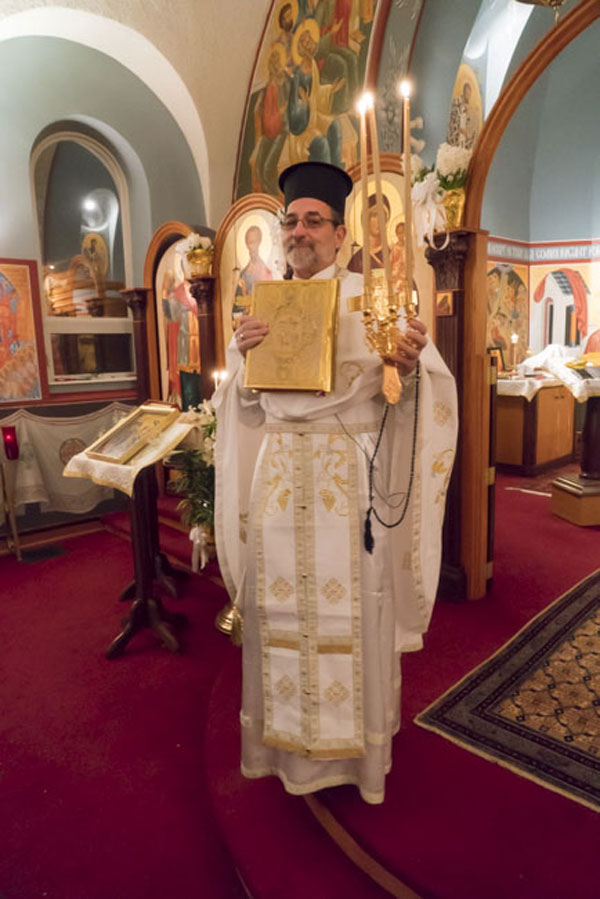
The entire tone of the service is changed. The dim interior of the church is gone. The dark vestments and candle holders are also gone. The tomb and somber music are also gone. The church is as bright as possible. The vestments are bright and the singing joyous. It is the triumphal resurrection of Christ saving us from death and granting us resurrection. Christ is risen! Glorify Him. The Hymn “Christ is Risen from the Dead” is sung repeatedly with joy and power. The Cry of “Christ is risen” and the response “Indeed he is risen.” fill the air. This is proclaimed in many different languages.
OCA – Christ is Risen! / Indeed He is Risen!
Greek Diocese – Christ is Risen! / Truly He is Risen!
Greek – Christos Anesti! / Aleithos Anesti!
Slavonic – Christos Voskrese! / Voistinu Voskrese!
Arabic – Al-Masih-Qam! / Hakkan Qam!
Romanian – Christos E Anviat! / Adeverat Anviat!
Spanish – Christo Ha Resucitado! / Verdaderamente, Ha Resucitado!
German – Christus ist Auferstanden! / Jawohl Er ist Auferstanden
French – Le Christ est ressuscite! / En verite il est resuscite!
Japanese – Harisutosu Siochatsu! / Makoto-ni Siochatsu
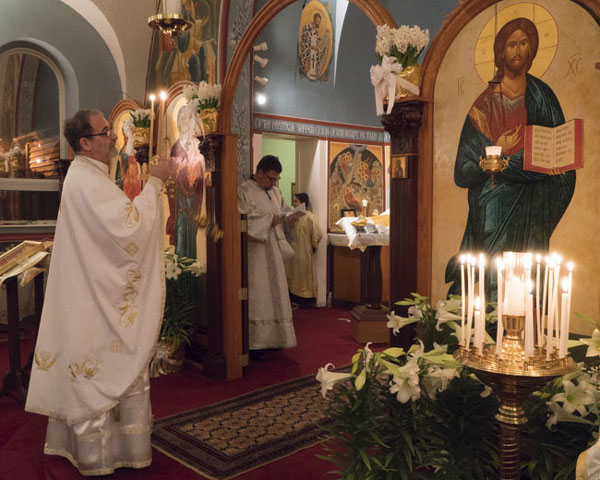
Scene from the service.
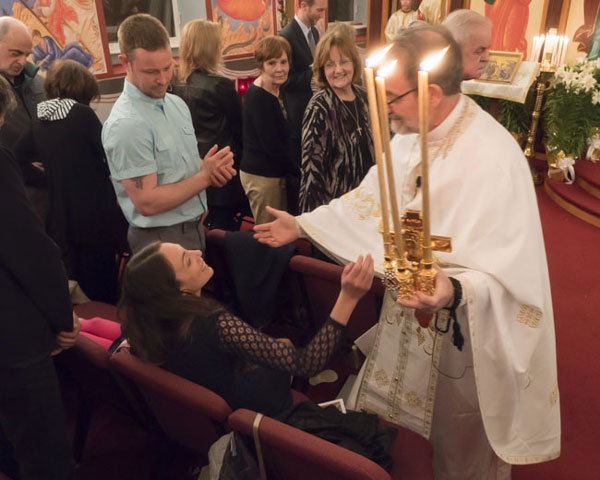
Scene from the service.
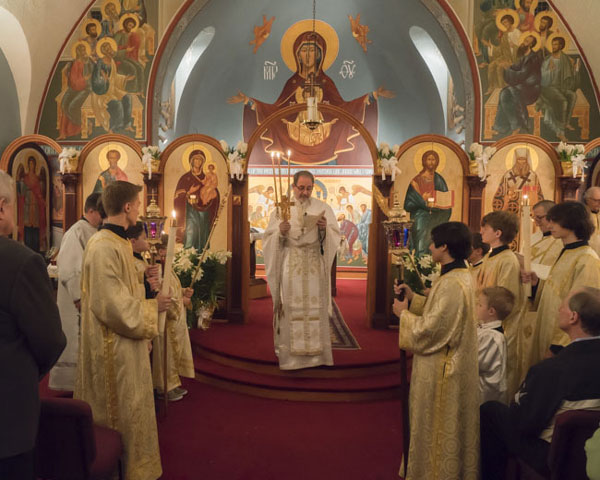
Fr. Paul reads the sermon of St. John Chrysostom welcoming all to the celebration.

Our bell ringers proclaim the Glory of the Risen Christ.
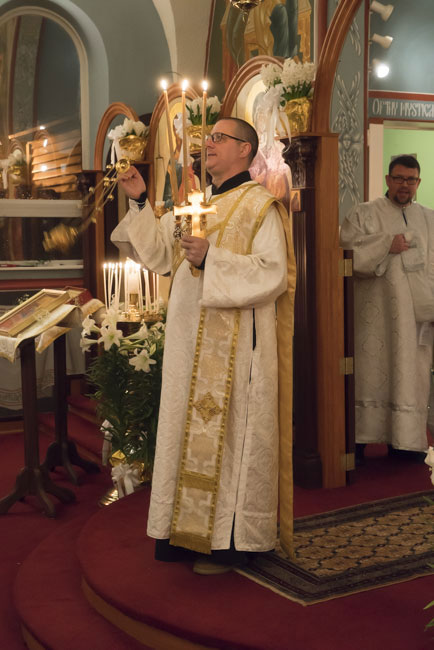
At the conclusion of the service, the parishioners venerate the Arthos and receive a red egg. All are invited to break the fast and break bread together.
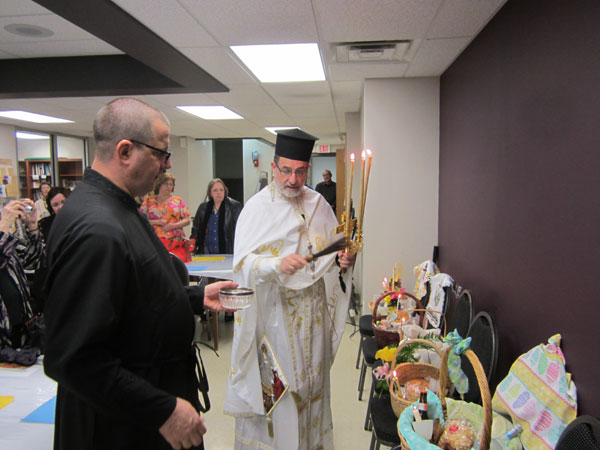
Father Paul blesses the baskets laden with food.
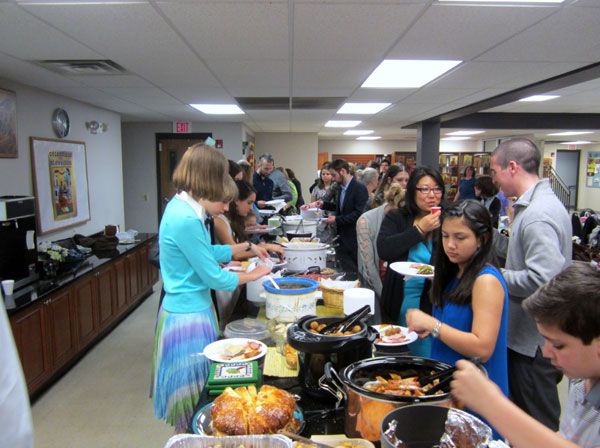
A pot luck dinner is served.
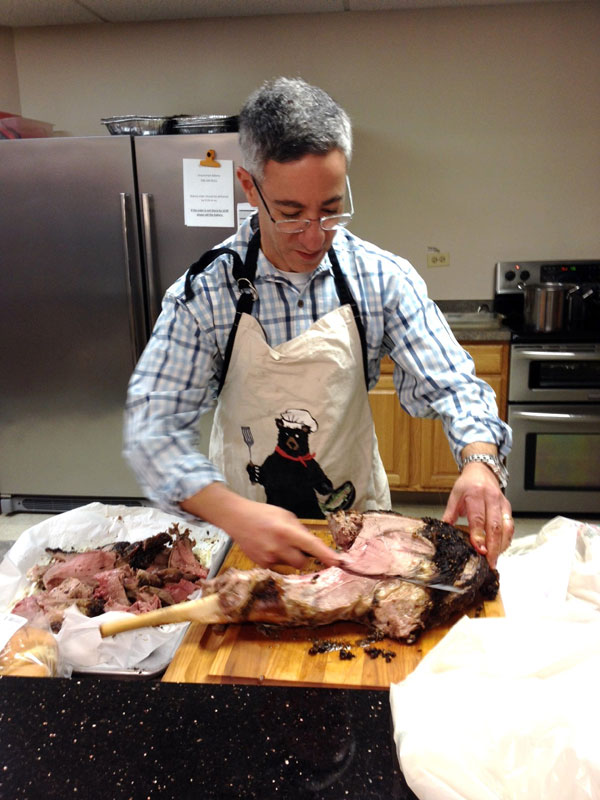
Lamb being prepared.
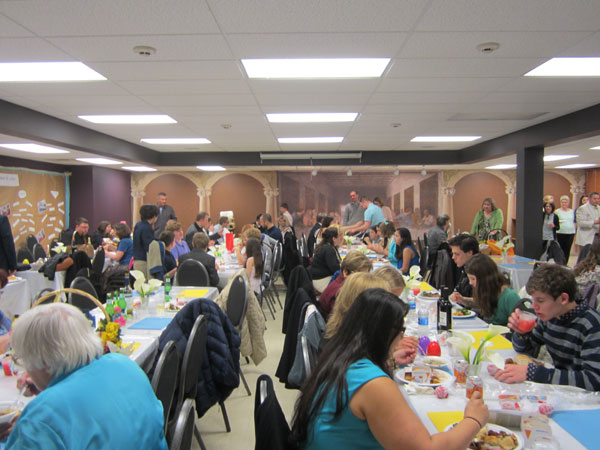
Orthodox Christians as they are able, fast from all meat and dairy products for all of Holy Week and the preceeding forty days of Lent. After the Paschal Liturgy a pot luck dinner is served and as you can imagine, some serious eating goes on. The celebration lasts into the early hours of the morning.
Agape Vespers And Egg Hunt
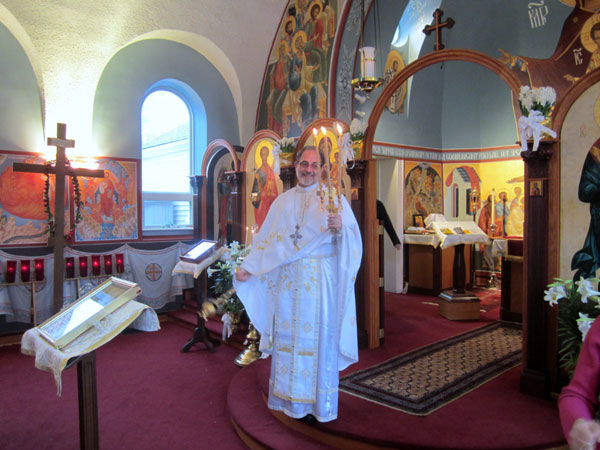
Sunday afternoon following Paschal Liturgy, the Agape Vespers service is celebrated. The church is bright and alive and full of children anticipating the Pascha egg hunt. The congregation gathers together to hear readings from the four Gospels in different languages proclaiming that Christ is Risen. Following this is a procession proclaiming the Risen Christ.
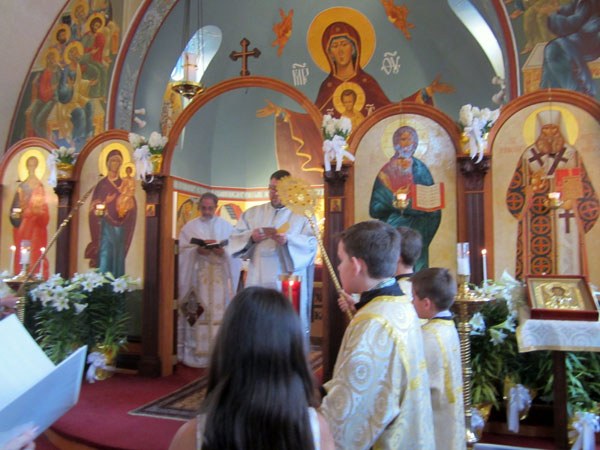
The Gospel in Spanish.

The Gospel in Armenian.
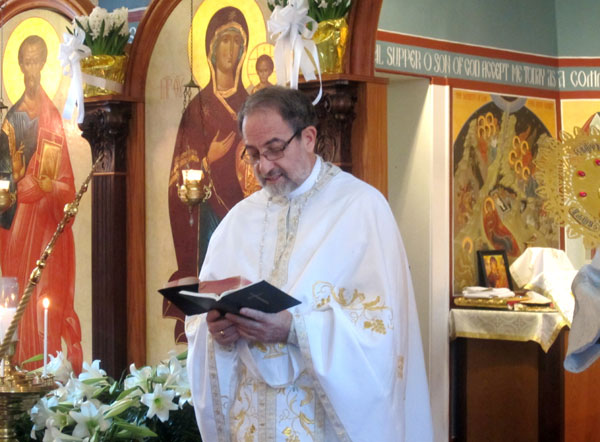
The Gospel in Greek.

The Gospel in English.
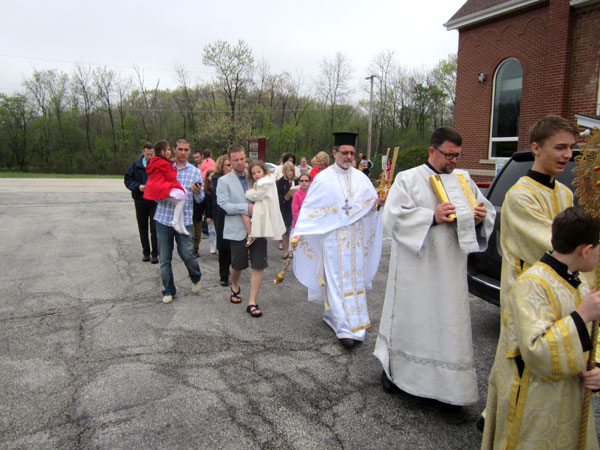
The congregation makes a procession around the church.
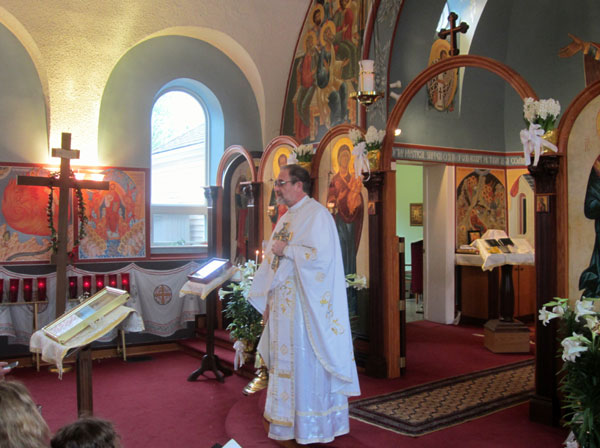
The congregation reenters the church for the dismissal.
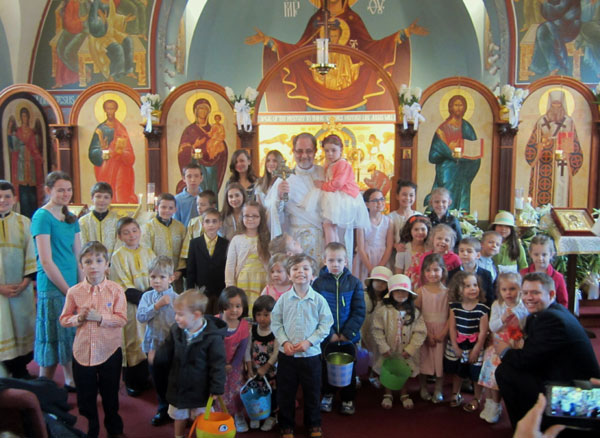
Group photo of Fr. Paul and the children.
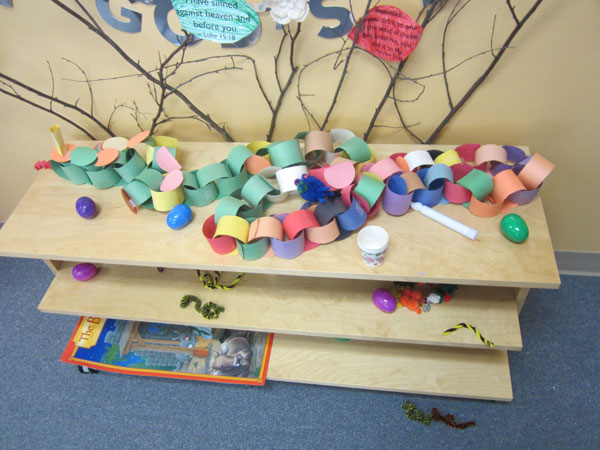
Due to inclement weather the Easter Bunny decided to hold the egg hunt in the church school classrooms this year.
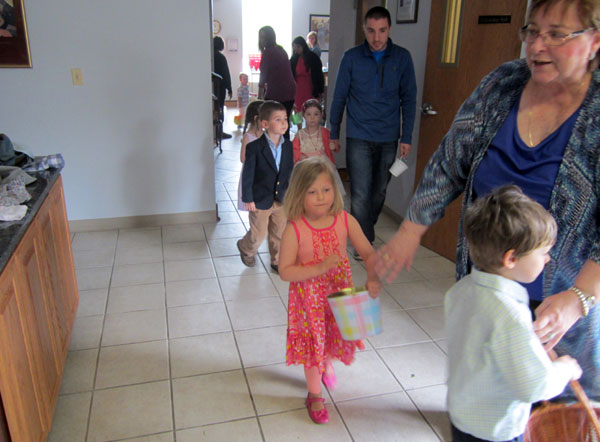
Get Ready! Get Set! Go!
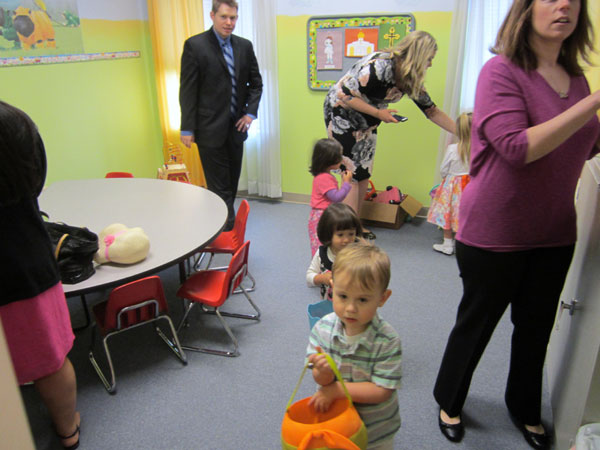
Scene from egg hunt.
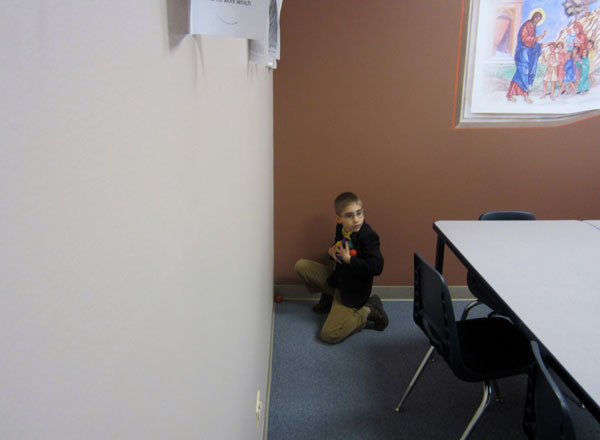
Scene from egg hunt.
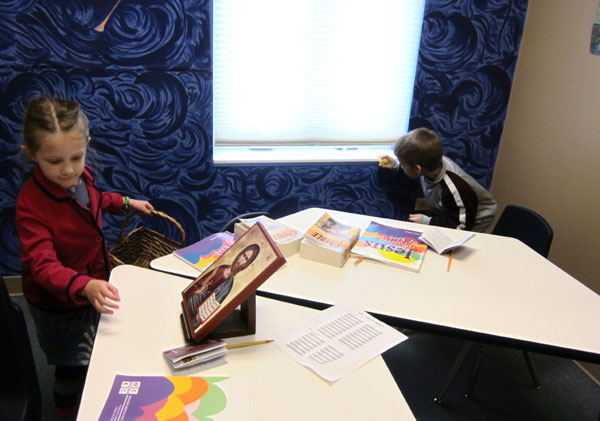
Scene from egg hunt.

Scene from egg hunt.
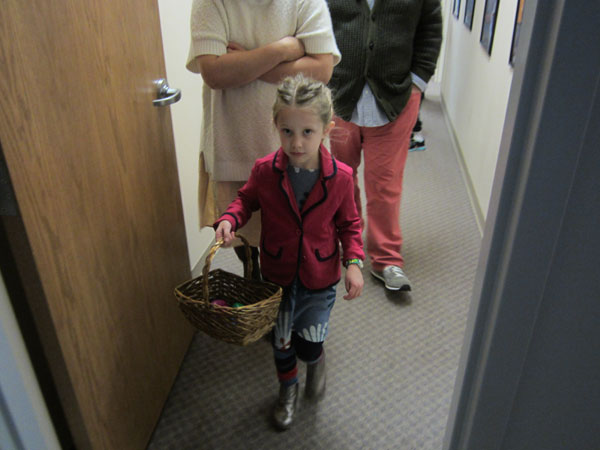
Thanks to all who set up the egg hunt for the children.
Christ Is Risen! Indeed He Is Risen!
THE DATING OF PASCHA (EASTER) IN THE ORTHODOX CHURCH
The Dating of Easter from the beginning was not a uniform thing. The earliest evidence from scriptures and tradition suggest that Jesus was crucified and died on the 14th day of the Jewish month of Nisan, a Friday. This means Jesus would have been resurrected on the 16th of Nisan, a Sunday.
This gave rise to the practice of celebrating the Resurrection on the 16th of Nisan irrespective of the day of the week it fell on, much as we celebrate the 4th of July. This was particularly true of the Christians in the Holy Lands, but nowhere else. Also in the Holy Lands there was a small body of Christians who celebrated the entire passion event including the Resurrection the 14th of Nisan. This date was called by them, “the Stavrosimon Pascha,” or “the Pascha of the Cross.”
The bulk of the Christians, however, particularly those in the West were fairly consistent in celebrating Easter on Sunday, but there was no agreement as to which Sunday. Hadrian, the Bishop of Rome in the second century was fairly successful in getting the other western churches to follow his lead, but when he tried to impose his solution on the churches in the East he was rebuked by no less a person than St. Polycarp the Bishop of Smyrna who died a martyr’s death.
Things remained fairly confused until the year 325 AD when the issue was settled by the First Ecumenical Council convened in Nicea in Asia Minor. While convened by the Emperor Constantine to resolve another issue, this council, the first of the entire Christian Church, also tackled many other problems as well. One was the date of Easter.
The First Council came up with the following formula. “Easter shall be the first Sunday after the first full moon after the first day of Spring following the Jewish Passover.” Thus all Christian Churches, east and west, celebrated Easter together for several centuries until the appearance of the “New” or “Gregorian” calendar.The Gregorian Calendar was adopted first by the Roman Catholic Church, and later, in the 18th century by the Protestants.The Eastern Orthodox Churches remained with the “Old” or “Julian” calendar until 1922, when some of them – the Churches of Greece, Cyprus, Antioch and the Ecumenical Patriarchate of Constantinople— adopted the “New.” The Slavic Churches, the Churches of Russia, Serbia, and also Mount Athos and the Patriarchate of Jerusalem, have remained with the “Old.” In this country the churches have adopted the New Calendar except for those with Slavic antecedents.For Orthodox Christians Easter is the Feast of Feasts so for this one celebration all Orthodox Christians use the old Julian calendar, for the dating of the first day of spring, which is 13 days behind the new Gregorian. Sometimes the difference in the date of Easter between East and West can be as much as five weeks. Other times the celebrations coincide. With the Julian calendar Easter always falls after the Passover of the Jews.
